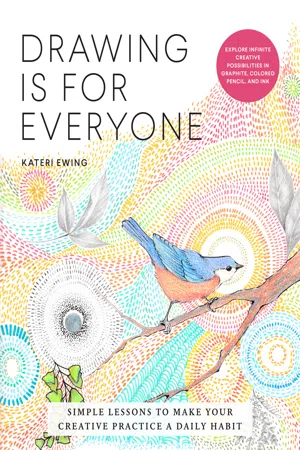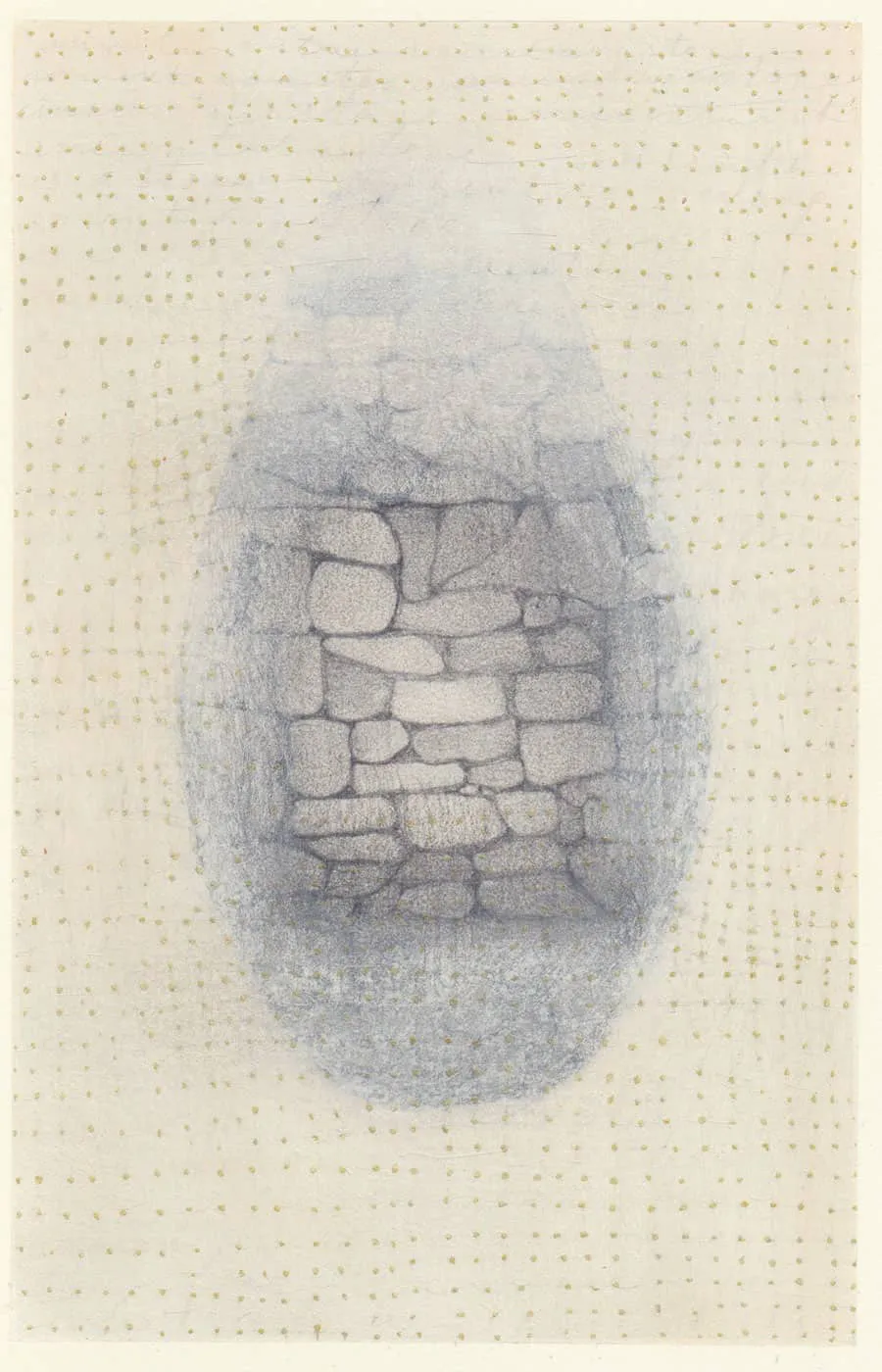
eBook - ePub
Drawing Is for Everyone
Simple Lessons to Make Your Creative Practice a Daily Habit - Explore Infinite Creative Possibilities in Graphite, Colored Pencil, and Ink
- 128 pages
- English
- ePUB (mobile friendly)
- Available on iOS & Android
eBook - ePub
Drawing Is for Everyone
Simple Lessons to Make Your Creative Practice a Daily Habit - Explore Infinite Creative Possibilities in Graphite, Colored Pencil, and Ink
About this book
Discover your unique inner artist through 21 intuitive, process-based lessons in drawing with graphite pencil, colored pencil, and ink—then joyfully share your works of beauty with the world.
In Drawing Is for Everyone, artist Kateri Ewing—author of Look Closer, Draw Better and Watercolor Is for Everyone—guides you through a series of simple creative drawing projects using a soulful, meditative, and reflective process. Whether you’re drawing for the first time or are an experienced artist, you’ll discover and deepen your creative potential through these exercises, because everyone can make art. Each lesson includes two art pieces, one to keep, and then a smaller one, such as a postcard or mini painting, to share or send out into the world, to spread their color, creativity, and joy in new places.
With Drawing Is for Everyone, you can learn how to build a daily drawing practice and how to set intentions and create, even if you have just 10 minutes a day. The projects draw inspiration from poetry, music, literature, and the natural world, and invite experimentation with a variety of sources. You'll pursue your personal passions through accessible projects as you build your drawing skills, confidence, and creativity.
In Drawing Is for Everyone, artist Kateri Ewing—author of Look Closer, Draw Better and Watercolor Is for Everyone—guides you through a series of simple creative drawing projects using a soulful, meditative, and reflective process. Whether you’re drawing for the first time or are an experienced artist, you’ll discover and deepen your creative potential through these exercises, because everyone can make art. Each lesson includes two art pieces, one to keep, and then a smaller one, such as a postcard or mini painting, to share or send out into the world, to spread their color, creativity, and joy in new places.
With Drawing Is for Everyone, you can learn how to build a daily drawing practice and how to set intentions and create, even if you have just 10 minutes a day. The projects draw inspiration from poetry, music, literature, and the natural world, and invite experimentation with a variety of sources. You'll pursue your personal passions through accessible projects as you build your drawing skills, confidence, and creativity.
Frequently asked questions
Yes, you can cancel anytime from the Subscription tab in your account settings on the Perlego website. Your subscription will stay active until the end of your current billing period. Learn how to cancel your subscription.
At the moment all of our mobile-responsive ePub books are available to download via the app. Most of our PDFs are also available to download and we're working on making the final remaining ones downloadable now. Learn more here.
Perlego offers two plans: Essential and Complete
- Essential is ideal for learners and professionals who enjoy exploring a wide range of subjects. Access the Essential Library with 800,000+ trusted titles and best-sellers across business, personal growth, and the humanities. Includes unlimited reading time and Standard Read Aloud voice.
- Complete: Perfect for advanced learners and researchers needing full, unrestricted access. Unlock 1.4M+ books across hundreds of subjects, including academic and specialized titles. The Complete Plan also includes advanced features like Premium Read Aloud and Research Assistant.
We are an online textbook subscription service, where you can get access to an entire online library for less than the price of a single book per month. With over 1 million books across 1000+ topics, we’ve got you covered! Learn more here.
Look out for the read-aloud symbol on your next book to see if you can listen to it. The read-aloud tool reads text aloud for you, highlighting the text as it is being read. You can pause it, speed it up and slow it down. Learn more here.
Yes! You can use the Perlego app on both iOS or Android devices to read anytime, anywhere — even offline. Perfect for commutes or when you’re on the go.
Please note we cannot support devices running on iOS 13 and Android 7 or earlier. Learn more about using the app.
Please note we cannot support devices running on iOS 13 and Android 7 or earlier. Learn more about using the app.
Yes, you can access Drawing Is for Everyone by Kateri Ewing in PDF and/or ePUB format, as well as other popular books in Art & Art Techniques. We have over one million books available in our catalogue for you to explore.
Information

THE LESSONS
I like to think of the twenty-one lessons that follow as a map that will lead you to a magical place of creative discoveries. Each lesson provides a method for exploring a different drawing technique that leads to spontaneous play. The instructions are not as technical as you might find in other books about drawing, and they are introduced by philosophies and thoughts to help you open your head, hands, and heart to exciting new possibilities.
You can choose to explore the lessons in any order; however, I recommend starting your journey with the first lesson of each section. These openers help you develop the basic skills needed to progress with confidence. Remember, keep your time commitment short and your tools and materials simple while you are making your creative practice a regular part of everyday life. If you can complete these twenty-one lessons, I have no doubt you will have made your creative practice a daily habit and will soon be looking for more time, every day, to explore mark making in your unique way.


GRAPHITE

You might be wondering why it’s called graphite, when it’s just a pencil. There are many kinds of pencils available to artists—from charcoal pencils to colored pencils, even carbon pencils. All have their place, and hopefully one day you’ll explore them. For now, we’ll focus on graphite pencils.
MATERIALS
Graphite is a gray, crystalline form of carbon with a metallic sheen; its name comes from the Greek graphein (“to write”). It’s the humble material used to make the no. 2 pencils we have used since grade school, and it’s also used to make the artist-grade pencils I hope you will try. Artist-grade graphite comes in varying degrees of hardness and softness. The hardest pencils, from H to 10H, create a paler, silvery, very defined line. The softest pencils, from B to 10B, create a smudgy, deep-gray line. HB is right in the middle of hardness and softness—the perfect balance—and is used to make the venerable no. 2 pencil.
For these lessons, I recommend a set of artist-grade pencils. A good variety of hardness and softness would be 2H, HB, 3B, 5B, 7B, and 9B.
You’ll also need:
- • An eraser, such as a kneaded (or putty) eraser, a stick eraser, or a white plastic eraser
- • A pencil sharpener. Always keep a very sharp point on your pencils, even using a bit of sandpaper to refine the tip after sharpening
- • Paper blending sticks or tortillons
- • Drawing paper. I prefer at least 90# paper with a vellum finish. Cotton is nice, but buy what you can afford. We’ll be using paper that’s about 5 × 7 inches (13 × 18 cm) for all projects. You can buy larger sheets and cut them to size, or buy pads already cut to that size.
- • Feather or clean soft brush to remove eraser dust and excess graphite from your paper

LESSONS
Our journey with graphite starts at the beginning: how to hold the pencil and put the material on the paper with a featherlight touch to give it the most beautiful appearance. Then, we explore the qualities of your individual mark and how that relates to seeing your subject and documenting what you see. We also explore the value (lightness and darkness) of your subject and the importance of capturing a three-dimensional object onto ...
Table of contents
- Cover
- Title Page
- Contents
- Introduction
- The Lessons
- Final Thoughts
- Resources
- Acknowledgments
- About the Author
- Index
- Copyright
- Dedication